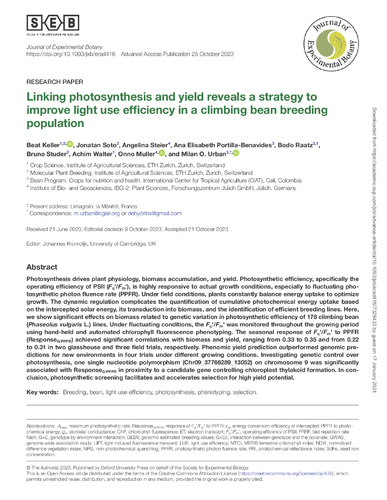Linking photosynthesis and yield reveals a strategy to improve light use efficiency in a climbing bean breeding population
Photosynthesis drives plant physiology, biomass accumulation and yield. Photosynthetic efficiency, specifically the operating efficiency of photosystem II (Fq'/Fm'), is highly responsive to actual growth conditions, especially to fluctuating photosynthetic photon fluence rate (PPFR). Under field conditions, plants constantly balance energy uptake to optimize growth. The dynamic regulation complicates the quantification of cumulative photochemical energy uptake based on the intercepted solar energy, its transduction into biomass and the identification of efficient breeding lines. Here, we show significant effects on biomass related to genetic variation in photosynthetic efficiency of 178 climbing bean (Phaseolus vulgaris L.) lines. Under fluctuating conditions, the Fq'/Fm' was monitored throughout the growing period using hand-held and automated chlorophyll fluorescence phenotyping. The seasonal response of Fq'/Fm' to PPFR (ResponseG:PPFR) achieved significant correlations with biomass and yield ranging from 0.33 to 0.35 and 0.22 to 0.31 in two glasshouse and three field trials, respectively. Phenomic yield prediction outperformed genomic predictions for new environments in four trials under rather different growing conditions. Investigating genetic control over photosynthesis, one SNP (Chr09_37766289_13052) on chromosome 9 was significantly associated with ResponseG:PPFR in proximity to a candidate gene controlling chloroplast thylakoid formation. In conclusion, photosynthetic screening facilitates and accelerates selection for high yield potential.

